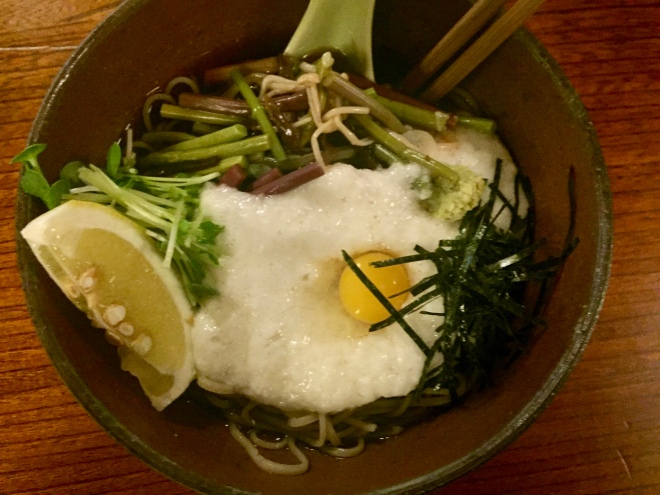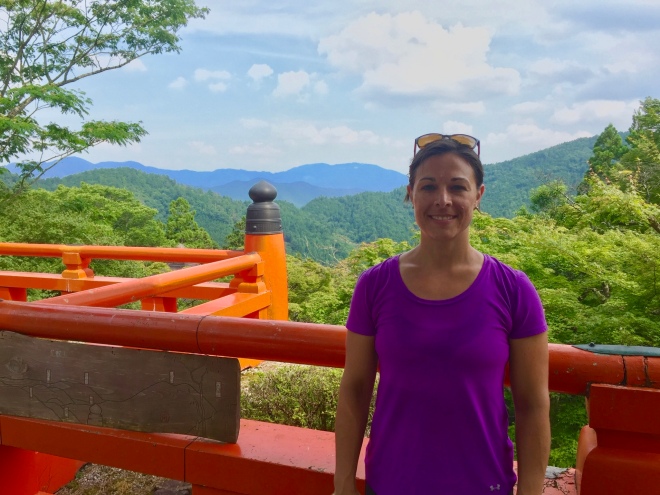I’ve been thinking about how to structure this post. A day by day accounting of each meal? I sort of already did that in my Japan itinerary post, though without pictures of the food. Just highlighting my favorite meals? But even the not-so-favorite meals are still interesting and memorable. So you’ll get a mix.
First, a few thoughts on my personal approach to eating in Japan.
- Eat whatever is put in front of me. Why not? I’m probably not going to be able to ask what it is or ask for something different, so just go for it. This led me to eat a few things that I had never eaten before (raw horse meat, sea urchin), things I typically detest (shrimp), and things I don’t necessarily detest but just don’t… choose to eat because I like almost everything else better (squid, octopus).
2. Don’t be too precious or indecisive. By this I mean, I wasn’t concerned about finding the most authentic Japanese meal/experience or the best sushi or ramen. From everything I’d heard about Japan, it was all going to be good. Quality and service are very important and food is respected. I didn’t want to spend time perseverating over this option or that option. Plus, I don’t speak Japanese, and I wasn’t prepared to get uncomfortable enough to put myself in situations that might have been required in order to find the most authentic experience. So did we end up at a lot of safe, guidebook-recommended, English- and tourist-friendly places? Yes. Was it delicious? Yes. Was it the most authentic experience and the best food I could have had there? Probably not, but I was 100% okay with that.
3. Must haves. These included very fresh sushi (Daiwa sushi, check); conveyor belt sushi (place in Ueno, Tokyo, check); wagyu beef (Otsuko Steak in Kyoto, check); and ramen (multiple checks).
4. Try new things. I ate a lot of things I’d never had before, including the items listed above and most of the street food in Osaka. It also included:
- Takoyaki: fried dough balls with octopus in them
- Okonomayaki: savory pancakes containing almost anything – noodles, eggs, meat, sauce, green onion, cabbage, etc.
- Japanese yam… paste? I don’t know what this stuff is called. We had it the first night in Tokyo at the Shinsuke izakaya with raw tuna. It was at the breakfast buffets in the Matsumoto and Yakushima hotels. And it was in this cold soba noodle dish at the cold soba and tempura restaurant in Matsumoto. It’s white (under the egg here) and had a sticky, pasty consistency and not a ton of flavor. I enjoyed it.

So, we ate well. We didn’t fuss about it too much. My most memorable food experiences include (in chronological order):
- Our first meal in Japan at Shinsuke Izakaya, obviously. It was our first meal! We each got a beer and we shared a sake. I don’t remember everything we got, but it included sashimi, the Japanese yam stuff I mentioned above, some pickled things. All in small dishes.
- Daiwa Sushi. We didn’t have a super fancy sushi dinner in Tokyo, which we debated. But this was damn good sushi, worth the wait.
- The izakaya, Soan Zama, in Matsumoto. As I mentioned in my first Japan post, we were the only customers, and the woman working did not know any English. There must have been at least one other employee cooking, but we never saw that person. We again each had a beer and shared a sake. We asked for something local. Dan ordered cold soba noodles and something else (I don’t remember). I ordered a set chicken dish, which I believe also came with rice, miso soup, and pickled vegetables. The woman watched us eat the whole time, essentially. Occasionally she would busy herself with something else, but mostly just watched us. We tried to just talk to each other normally, but it was tough. Still, the woman was adorable and the service and food so wonderful.
- Dinner and breakfast at our ryokan, Shirouma-so, in Hakuba. Both were set course meals like I’ll show below for kawa doko. Both included whole fried fish, only one of which I ate the whole thing (head and all). Dinner also included a pot thing for cooking meat. It was clay maybe, and the meat cooked in liquid in a tray over a candle. When the candle was done burning, the meat was ready. We were told, if we wanted, to crack an egg into a bowl we had and dunk the meat in the raw egg before eating it. It was delicious. The meals also had miso soup, rice, and various pickled vegetables. Dinner had tempura vegetables and shrimp also. Breakfast had yogurt and melon and a crepe with a cooked but egg in it.
- Eating in Osaka. I’ve already talked about takoyaki and okonomayaki, both of which we ate in restaurants in between strolling along the Dotombori canal and Dotombori street at night. The next morning, we went to Kuromon market and saw and ate a ton. There was so much food. The first thing I ate was a sort of meat and egg on a stick (pictured below). Then we got this cucumber salad with octopus in it (I mostly at the cucumber, Dan ate the octopus, but I did have a bite). Dan got this enormous scallop, which was cooked for him in butter over charcoal in its own shell. We ate eel, we ate eel over egg, we ate takoyaki, we ate a peach smoothie. And I’m pretty sure there were a few more things on sticks in there.
- Kawa doko, eating on platforms above the flowing river, in Kibune. This was a set course meal. Dan and I were starving and both ordered the option with the most things. And beer. The meal included fish, sashimi, pickled vegetables, rice, miso soup, tempura, noodles, and probably other things I am forgetting. So many of our meals were like this in that they involve so many little, beautiful dishes – for the soup, for the rice, for the pickled vegetables, etc. It’s a lovely way to eat.
- Lunch at the Kagoshima Toppy Hydrofoil port restaurant. Like a few other places we’d eaten (breakfast in the Shinjuku train station in Kyoto, lunch at Subaru Fifth Station on Mt. Fuji before hiking), we ordered via a machine that spits out a ticket, which you then hand to the hostess. In this case, the machine had no English nor pictures. But a poster next to it had pictures and prices, so we were able to figure out which button to push by finding the only one with the specific price of what we wanted. This place is memorable to me because it felt truly diner-like. Not run down, but sort of divey feeling. I loved it. Our ramen was sort of greasy and wonderful. Some of the other patrons were clearly also on their way to Yakushima (where we were departing on the hydrofoil from Kagoshima to) and were sort of hippy hiker-seeming. It just sticks out.
Finally, just a few other food/drink experiences worth mentioning, because I have the pictures:
- Drink vending machines are everywhere. They have a lot of sugary sodas and coffee. And pocari sweat, a Gatorade-type drink that was really refreshing when we were walking around Kyoto!
- Our first breakfast in Japan was at a fast food French cafe breakfast place. We got pastries with ham and cheese maybe, in rice flour dough. They were actually kind of delicious. (See above where I talk about not insisting on the most authentic experience.)
- I did a tiny bit of research to find good coffee in Tokyo and found Nozy Coffee Roastery. I think these lattes were like $7 or $8 each. They were good, though, and much needed after walking a ton (this was the day of 33,000+ steps).
- We shopped at 7-Eleven a few times (including for fruit and salad when I was really struggling! which they had! they have everything in Japan!), and they must have been running some sort of promotion. Twice, they motioned for Dan to stick his hand in this box and pull out a piece of paper. I forget what he ‘won’ the second time, but the first time was a bag of shrimp-flavored puffed starchy things. Dan ate the bag for breakfast the morning we left Tokyo.
- Dan got green tea ice cream before we started on the Path of Philosophy in Kyoto when his blood sugar was dipping dangerously low and he was feeling hungry.
- The food sold by vendors at the Gion festival celebrations in Kyoto was similar to the street food in Osaka. Lots of fried things on sticks. The lines were crazy.
- Our lunch in Hiroshima. I need to go look up that name and I’ll update this. I had a nice meal of pork, rice, miso soup. The place was really cute and cozy.
- For breakfast or lunch (timing was weird) in the Kagoshima airport on our way from Yakushima back to Tokyo back to Baltimore, I ordered something without having really ANY IDEA what I was getting. Turns out, it was this ground beef with egg ribbons. That looks like cheddar cheese, but it’s egg. And miso and rice and pickled vegetables of course. And, of course, our on-mountain ‘dinner’ at the Mt. Fuji hut at 3,400 meters. Not the tastiest meal ever, but it was food. Japanese curry (which was a thing), a sausage? patty, sausage links, rice, and pickled vegetables.
Hooray!
































































































